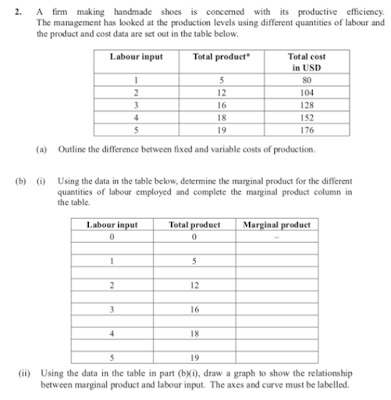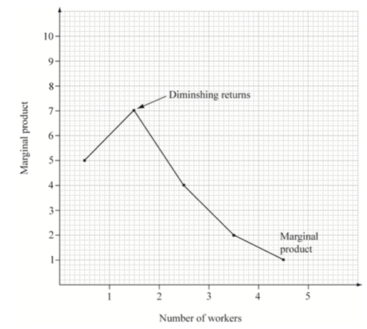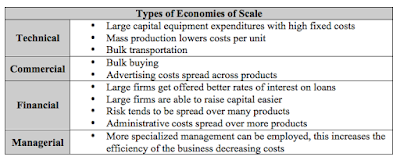 |
(a) Outline the difference between fixed and variable costs of production.
Variable Costs – change with changing output (think labor) while,
Fixed costs do not change when output changes (think rent).
If you produce more you must hire more labor but no matter if you produce 1 taco or 10,000 tacos your rent for the month will not change.
(b) (i) Using the data in the table below, determine the MP for the different quantities of labor employed and complete the MP column in the table.
(ii) Using the data in the table in part (b) (i) draw a graph to show the relationship between marginal product and labor input. The axes and curves must be labeled.
(iii) On the graph, identify where diminishing returns set in. (3rd worker)
Horizontal Axes may be (Number of workers, Labor, L or QL)
MP points may be above or between the units of workers.

(ii) Using the data in the table, determine the marginal cost and average total cost figures for the different quantities of total product and complete the MC and ATC columns.
Recognize that when the output is 0 (zero) and there are Costs they must be fixed costs as with no production VC are zero.
FC is constant so the same all the way down
VC = TC – FC
MC = Change in TC/Change in Quantity With 1 unit of labor (4.8 = 24/5)
ATC = TC/Q
AFC = FC/Q
AVC = VC/Q
(iii) Using the data in the table in part (c) (ii), draw a graph to show the firm’s average total cost curve. Axes and curves must be labeled.
Horizontal Axes (Output or Quantity of shoes)
Vertical Axes (Costs, average (total) costs, $)
(iv) Define the term Productive Efficiency
Productive Efficiency = P = Minimum of the ATC
Where a firm produces at the lowest unit or average total cost
(or where MC = ATC)
(d) Explain how the law of diminishing returns affects this firm’s marginal costs.
If MP decreases then MC’s increase and vive versa and as input increases (labor) the resulting increases in output become smaller. As a result, the additional cost of one more unit of output (the MC) will begin to increase.
(e) Explain one possible source of economies of scale that this firm might benefit from if it increases its scale of production.










No comments:
Post a Comment